Lumped Parameter Modeling of SAE J2601 Hydrogen Fueling Tests
Abstract
:1. Introduction
2. Thermodynamic Model for Hydrogen Refueling
3. Matlab/Simulink Model for Hydrogen Refueling
4. Results
4.1. Comparison of Lookup Table Fueling and MC Default Fueling for Type IV 249 L Tank
4.2. Results of Simulation of SAE J2601 Hydrogen Refueling Data

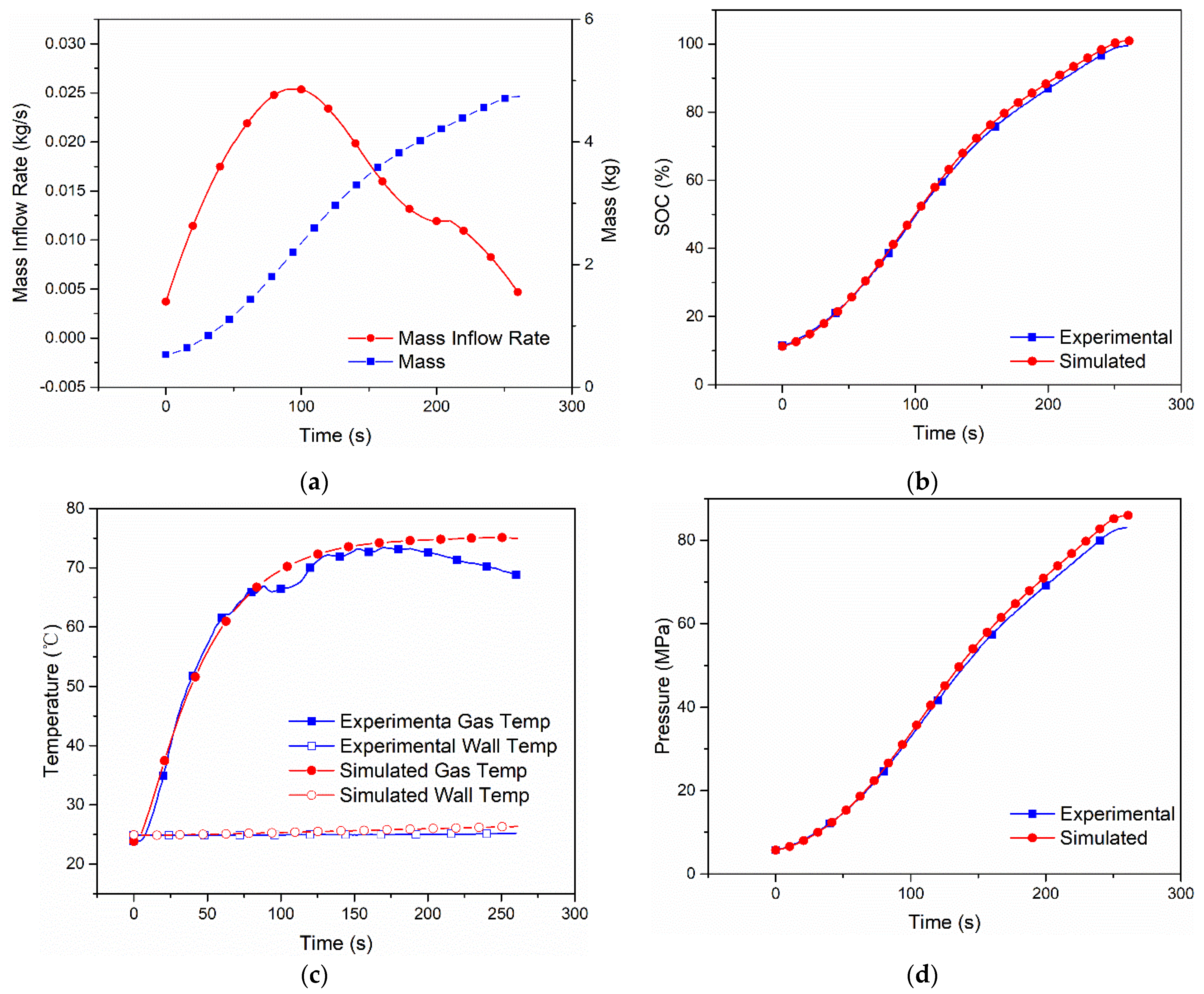
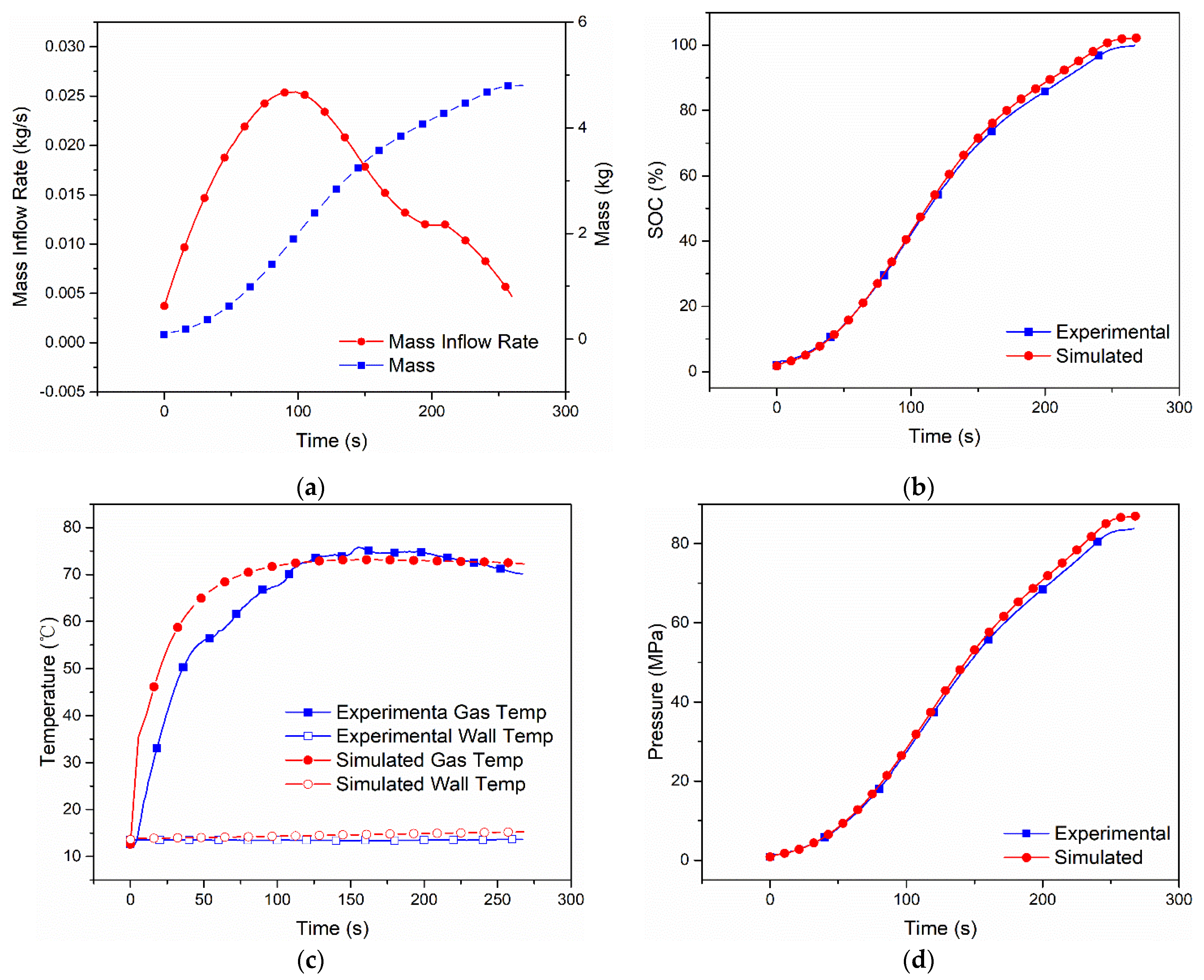
4.3. Determination of Final Hydrogen Temperature by Initial Hydrogen Temperature and Gas Inflow Hydrogen Temperature
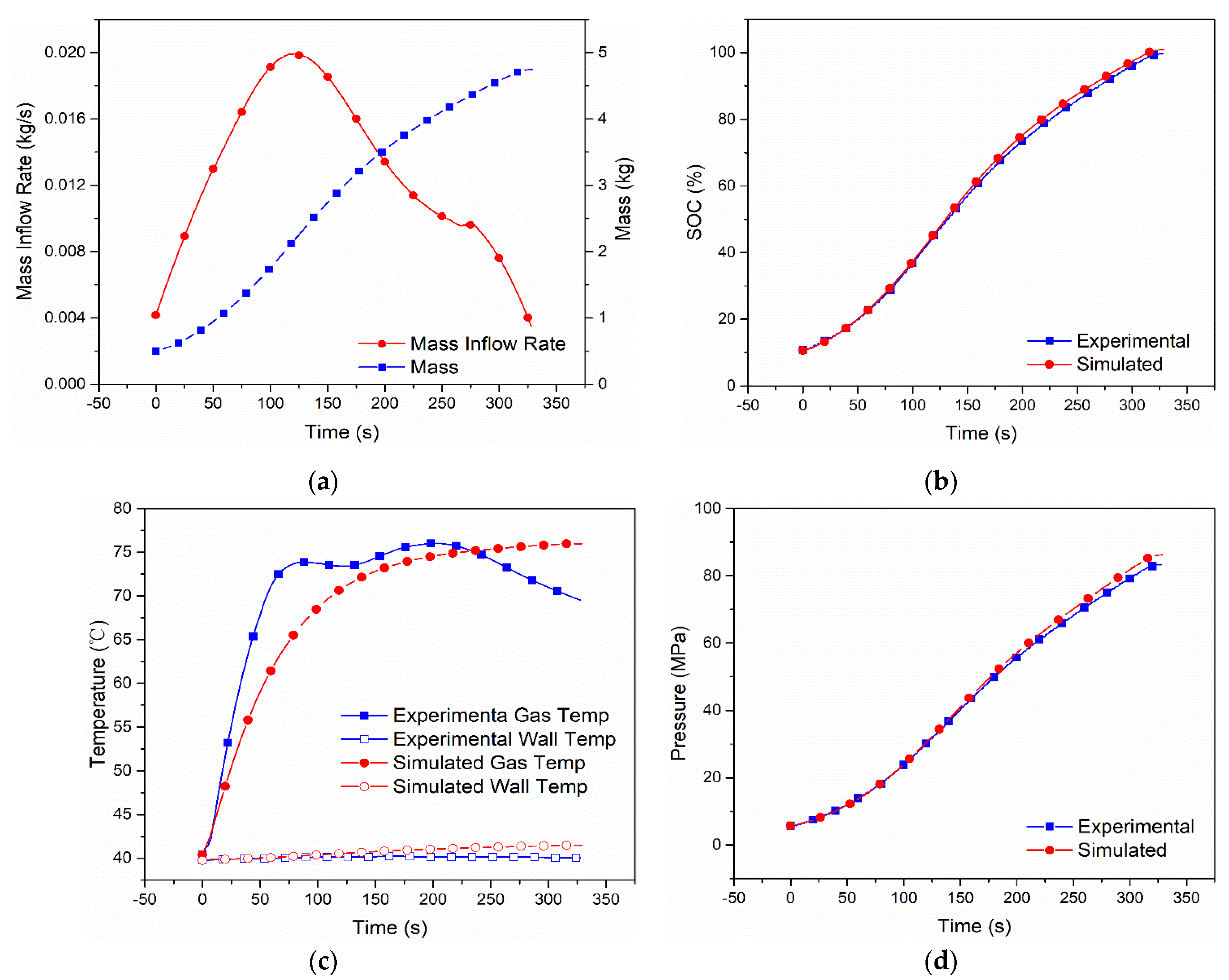
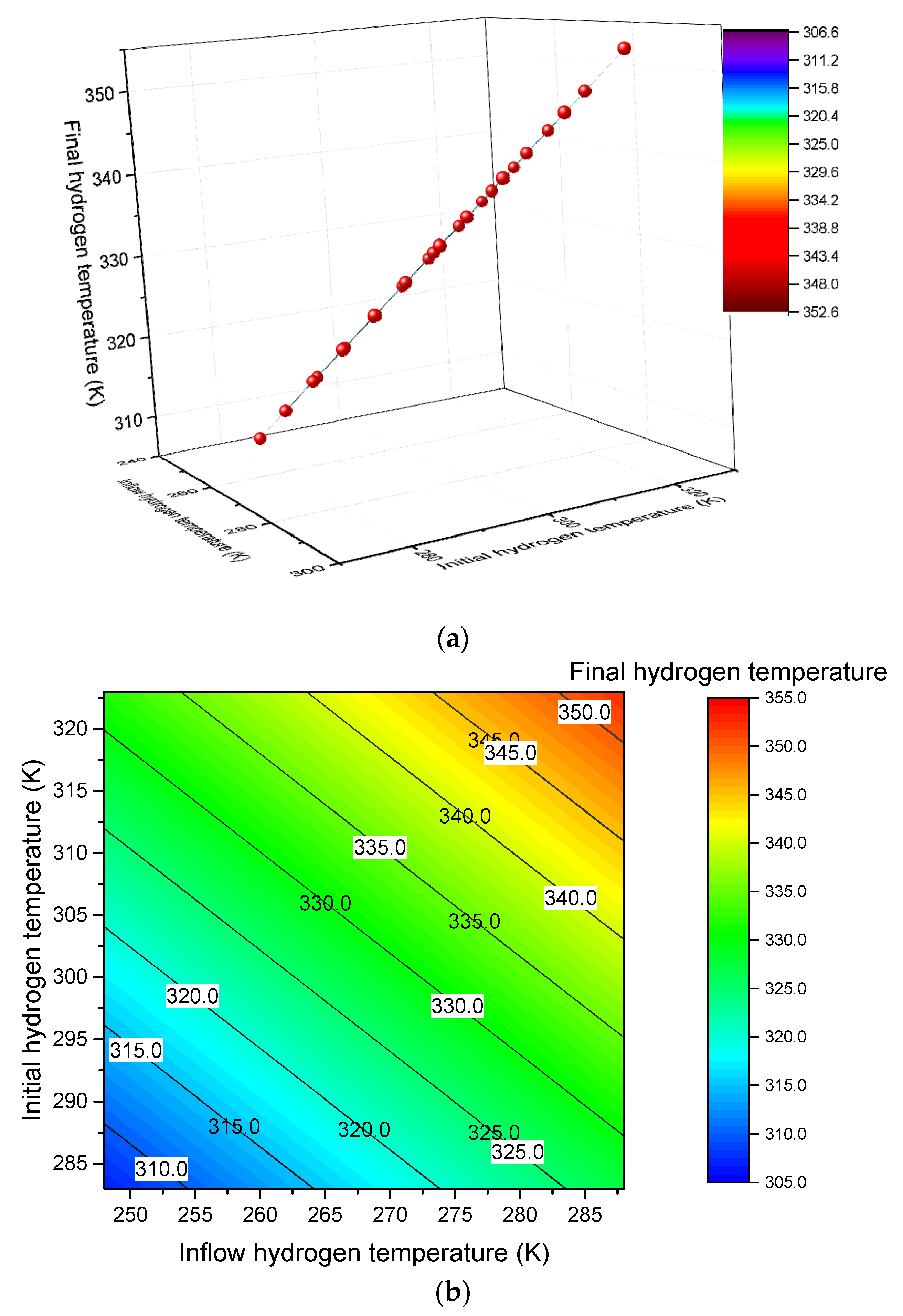
5. Discussion
6. Conclusions
- (1)
- The dual-zone lumped parameter model has good ability to express the reference data, so that the model would be utilized to predict the SOC in other practices.
- (2)
- The heat transfer between hydrogen and the tank wall is complicated. Accurate modeling of heat transfer coefficients is somewhat difficult, which will be the direction of our future efforts.
- (3)
- The dual-zone lumped parameter model can also well predict the hydrogen temperature and further predict the pressure in the tank from this hydrogen temperature and the well-predicted hydrogen mass by using the real gas equation of state.
- (4)
- The maximum difference between simulated and experimental wall temperatures for five cases is around 2 °C. The experimental wall temperatures were measured on the outer tank wrap surface where the thermocouples attach. In the dual-zone lumped parameter model, the simulated wall temperature is representative of a mean temperature averaged alone with the radial direction, which is higher than the external surface temperature of the tank wrap.
- (5)
- The analytical solution of the hydrogen temperature deduced by the dual-zone lumped parameter model can be used to determine the functional relationship between the final hydrogen temperature with the initial and gas inflow hydrogen temperatures. The three-dimensional surface and the contour fitting can be carried out using Origin software.
- (6)
- With the fitted results, the mathematical relationship between the final, initial and inlet hydrogen temperatures under certain charge conditions can be obtained, further estimating the final fueling state of the hydrogen. In the future, we will continue to derive the analytical solutions for the inflow temperature, the final SOC and the hydrogen pressure in the tank.
Author Contributions
Funding
Institutional Review Board Statement
Informed Consent Statement
Data Availability Statement
Conflicts of Interest
References
- Hoel, M.; Kverndokk, S. Depletion of fossil fuels and the impacts of global warming. Resour. Energy Econ. 1996, 18, 115–136. [Google Scholar] [CrossRef]
- Gregg, J.S.; Andres, R.J.; Marland, G. China: Emissions pattern of the world leader in CO2 emissions from fossil fuel consumption and cement production. Geophys. Res. Lett. 2008, 35, L08806. [Google Scholar] [CrossRef]
- Benton, M.J.; Wills, M.A.; Hitchin, R. Quality of the fossil record through time. Nature 2000, 403, 534. [Google Scholar] [CrossRef] [PubMed]
- Suryan, A.; Kim, H.D.; Setoguchi, T. Comparative study of turbulence models performance for refueling of compressed hydrogen tank. Int. J. Hydrogen Energy 2014, 48, 9562–9569. [Google Scholar] [CrossRef]
- Dunn, S. Hydrogen futures: Toward a sustainable energy system. Int. J. Hydrogen Energy 2002, 27, 235–264. [Google Scholar] [CrossRef]
- Elam, C.C.; Padró, C.E.G.; Sandrock, G. Realizing the hydrogen future: The International Energy Agency’s efforts to advance hydrogen energy technologies. Int. J. Hydrogen Energy 2003, 28, 601–607. [Google Scholar] [CrossRef]
- Zheng, J.; Liu, X.; Xu, P. Development of high pressure gaseous hydrogen storage technologies. Int. J. Hydrogen Energy 2012, 37, 1048–1057. [Google Scholar] [CrossRef]
- SAE J2601_202005: Fueling Protocols for Light Duty Gaseous Hydrogen Surface Vehicles. Available online: https://www.sae.org/standards/content/j2601_202005/ (accessed on 1 January 2023).
- SAE J2601_201407: Fueling Protocols for Light Duty Gaseous Hydrogen Surface Vehicles. Available online: https://www.sae.org/standards/content/j2601_201407/ (accessed on 1 January 2023).
- SAE J2601_201612: Fueling Protocols for Light Duty Gaseous Hydrogen Surface Vehicles. Available online: https://www.sae.org/standards/content/j2601_201612/ (accessed on 1 January 2023).
- Harty, R.; Mathison, S. Improving hydrogen tank refueling performance through the use of an advanced fueling algorithm-the MC method. In Proceedings of the National Hydrogen Association Conference, Long Beach, CA, USA, 3–6 May 2010. [Google Scholar]
- Mathison, S.; Handa, K.; McGuire, T.; Brown, T. Field validation of the MC default fill hydrogen fueling protocol. SAE Int. J. Altern. Powertrains 2015, 4, 140–144. [Google Scholar] [CrossRef]
- Schneider, J.; Meadows, G.; Mathison, S.; Veenstra, M. Validation and sensitivity studies for SAE J2601, the light duty vehicle hydrogen fueling standard. SAE Int. J. Altern. Powertrains 2014, 4, 257–409. [Google Scholar] [CrossRef]
- Mathison, S.; Harty, R. Application of MC method-based H2 fueling. In Proceedings of the SAE 2012 World Congress & Exhibition, Detroit, MI, USA, 24–26 April 2012. [Google Scholar]
- Reddi, K.; Elgowainy, A.; Rustagi, N. Impact of hydrogen SAE J2601 fueling methods on fueling time of light-duty fuel cell electric vehicles. Int. J. Hydrogen Energy 2017, 42, 16675–16685. [Google Scholar] [CrossRef]
- Melideo, D.; Baraldi, D. Erratum to “CFD analysis of fast filling strategies for hydrogen tanks and their effects on key-parameters”. Int. J. Hydrogen Energy 2015, 40, 6260–6268. [Google Scholar] [CrossRef]
- Striednig, M.; Brandstätter, S.; Sartory, M. Thermodynamic real gas analysis of a tank filling process. Int. J. Hydrogen Energy 2014, 39, 8495–8509. [Google Scholar] [CrossRef]
- Galassi, M.C.; Baraldi, D.; Iborra, B.A. CFD analysis of fast filling scenarios for 70 MPa hydrogen type IV tanks. Int. J. Hydrogen Energy 2012, 37, 6886–6892. [Google Scholar] [CrossRef]
- Suryan, A.; Kim, H.D.; Setoguchi, T. Numerical analysis on thermo-fluid dynamic behavior of hydrogen gas during fast high pressure filling. J. Mech. Sci. Technol. 2013, 27, 567–573. [Google Scholar] [CrossRef]
- The Hydrogen Data-Sharing Site. Available online: http://www.h2protocol.com/h2-fueling-data/ (accessed on 1 January 2023).
- Ebru, G.; Mehmet, G.G.; Taner, B. Multi-period planning of hydrogen refuelling stations using flow data: A case study for Istanbul. Int. J. Hydrogen Energy 2022, 47, 40138–40155. [Google Scholar]
- Tim, B.; Hilary, K. Analysis of customer queuing at hydrogen stations. Int. J. Hydrogen Energy 2022, 47, 17107–17120. [Google Scholar]
- Matteo, G.; David, B.; Michael, D.; Petronilla, F. Hydrogen losses in fueling station operation. J. Clean. Prod. 2020, 248, 119266. [Google Scholar]
- Matteo, G.; David, B.; Michael, D.; Petronilla, F. Hydrogen station in situ back-to-back fueling data for design and modeling. J. Clean. Prod. 2021, 329, 129737. [Google Scholar]
- Xiao, J.S.; Wang, X.; Benard, P.; Chahine, R. Determining hydrogen pre-cooling temperature from refueling parameters. Int. J. Hydrogen Energy 2016, 41, 16416–16421. [Google Scholar] [CrossRef]
- Xiao, J.S.; Benard, P.; Chahine, R. Charge-discharge cycle thermodynamics for compression hydrogen storage system. Int. J. Hydrogen Energy 2016, 41, 5541–5549. [Google Scholar] [CrossRef]
- Xiao, J.S.; Wang, X.; Zhou, X.; Bénard, P.; Chahine, R. A dual zone thermodynamic model for refueling hydrogen vehicles. Int. J. Hydrogen Energy 2019, 44, 8780–8790. [Google Scholar] [CrossRef]
- National Institute of Standards and Technology (NIST). Reference Fluid Thermodynamic and Transport Properties Database (REFPROP) Version 9.0 [Software]. 2010. Available online: https://www.nist.gov/srd/refprop (accessed on 1 January 2023).
- Xiao, J.S.; Benard, P.; Chahine, R. Estimation of final hydrogen temperature from refueling parameters. Int. J. Hydrogen Energy 2017, 42, 7521–7528. [Google Scholar] [CrossRef]
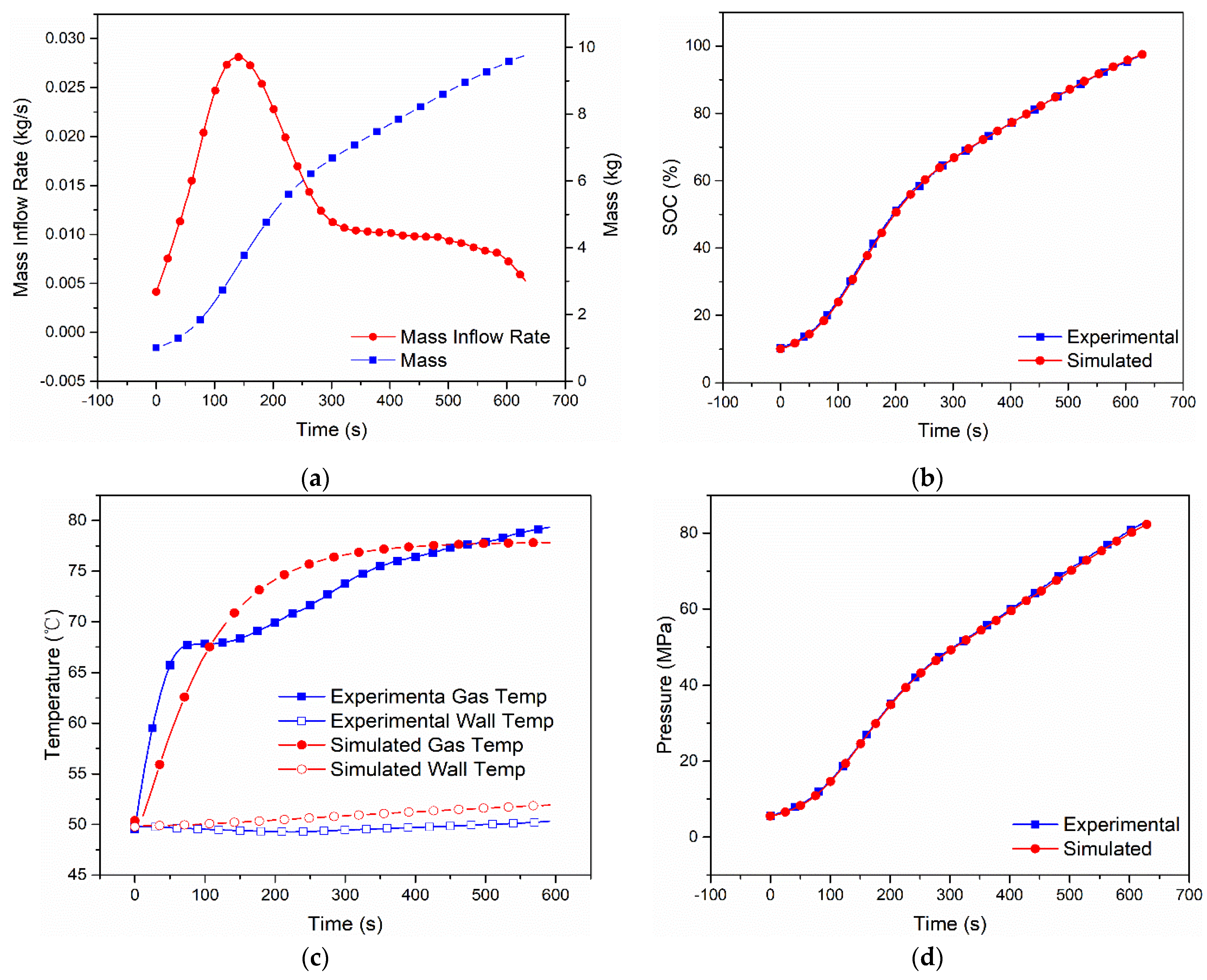
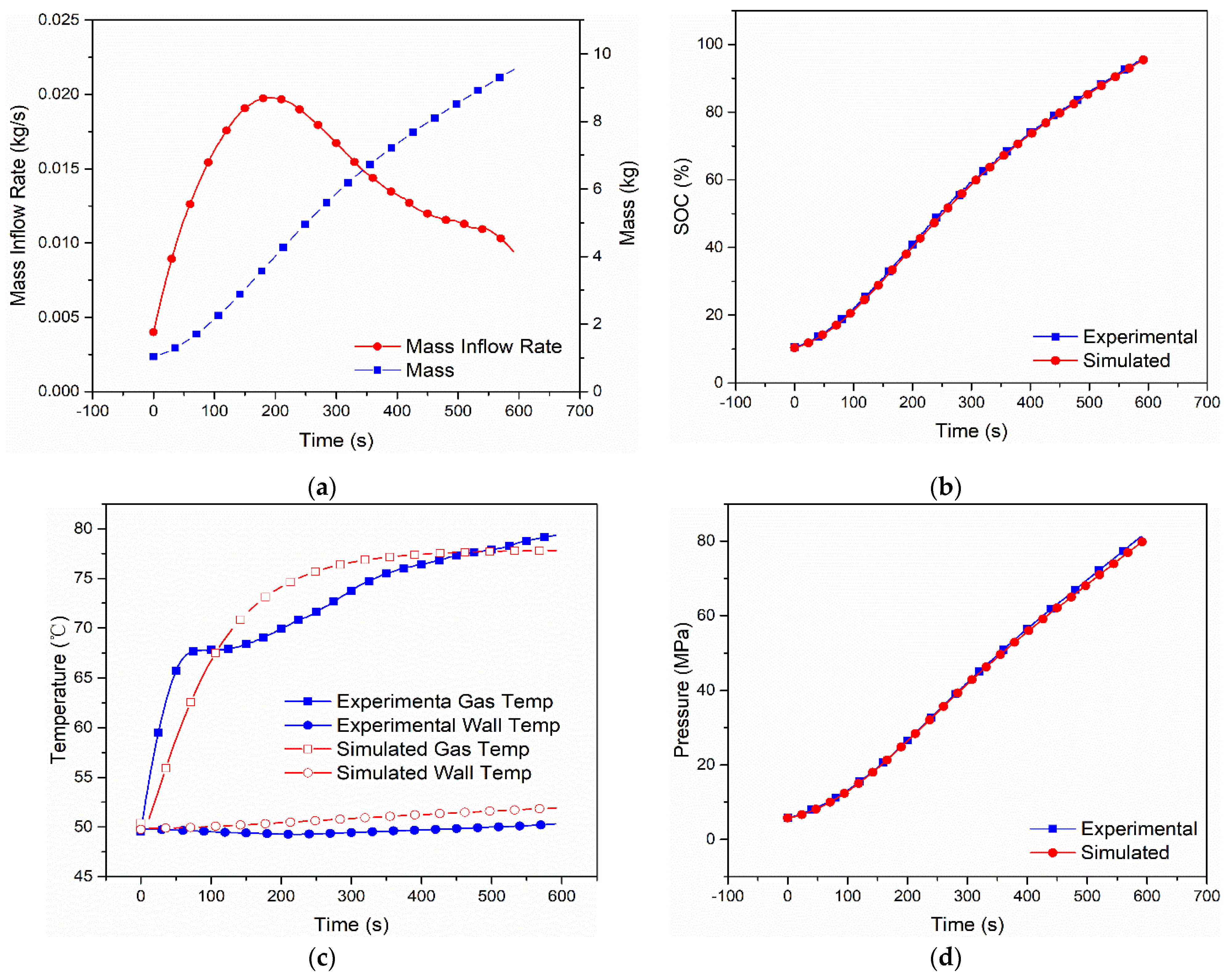
| Parameter | Description | Type IV 249 L | Type IV 117 L |
|---|---|---|---|
| NWP (MPa) | Nominal working pressure of tank | 70 | 70 |
| (kg) | Storage capacity of tank | 9.8 | 4.7 |
| (m2) | Inner surface area of tank | 2.2 | 1.3 |
| (m2) | External surface area of tank | 2.7 | 1.6 |
| (m3) | Volume of tank | 0.249 | 0.117 |
| (kg) | Mass of the lining | 10.1 | 5.6 |
| (kg) | Mass of the wrap | 135.6 | 82.7 |
| (kg) | Mass of the wall | 145.7 | 88.1 |
| (J/(kg·K)) | Heat capacity of the lining | 2100 | 2100 |
| (J/(kg·K)) | Heat capacity of the wrap | 1120 | 1120 |
| (J/(kg·K)) | Heat capacity of the wall | 1188 | 1185 |
| Parameter | Description | Value |
|---|---|---|
| (J/(kg·K)) | Constant-pressure heat capacity of hydrogen | 14,700 |
| (J/(kg·K)) | Constant-volume heat capacity of hydrogen | 10,500 |
| (kg/mol) | Molecular weight of hydrogen | 2.0159 × 10−3 |
| (W/(m2·K)) | Heat transfer coefficient between gas and wall | 80 |
| (W/(m2·K)) | Heat transfer coefficient between wall and environment | 20 |
| Parameter | Description | Case 1 | Case 2 | Case 3 | Case 4 | Case 5 |
|---|---|---|---|---|---|---|
| (L) | Volume of tank | 249 | 249 | 117 | 117 | 117 |
| (MPa) | Initial pressure in the tank | 5.5 | 5.7 | 5.76 | 0.83 | 5.68 |
| (K) | Initial temperature in the tank | 323 | 323 | 297 | 286 | 313 |
| (s) | Refueling time | 629 | 591 | 261 | 268 | 329 |
| (K) | Gas inflow temperature | 248 | 243 | 248 | 243 | 240 |
| Parameter | Description | Type IV |
|---|---|---|
| Ain (m2) | Inner surface area of tank | 1.3 |
| Aout (m2) | External surface area of tank | 1.6 |
| V (m3) | Volume of tank | 0.117 |
| mw (kg) | Mass of the wall | 88.1 |
| cw (J/kg/K) | Heat capacity of the wall | 1185 |
| p0 (MPa) | Initial pressure in the tank | 5.76 |
| t (s) | Refueling time | 261 |
| Initial Hydrogen Temperature | Inflow Hydrogen Temperature | ||||
|---|---|---|---|---|---|
| 248 (K) | 258 (K) | 268 (K) | 278 (K) | 288 (K) | |
| 323 (K) | 331.9487 | 337.1256 | 342.3025 | 347.4795 | 352.6564 |
| 313 (K) | 325.6366 | 330.8094 | 335.9823 | 341.1552 | 346.3281 |
| 303 (K) | 319.3178 | 324.4864 | 329.6549 | 334.8235 | 339.992 |
| 293 (K) | 312.9917 | 318.1557 | 323.3196 | 328.4835 | 333.6474 |
| 283 (K) | 306.6575 | 311.8165 | 316.9755 | 322.1344 | 327.2934 |
| Parameter | Fitting Value | Standard Error | R-Square |
|---|---|---|---|
| 0.51566 | 3.01394 × 10−4 | 0.9999 | |
| 1.30456 | 2.65436 × 10−4 | 0.9999 |
Disclaimer/Publisher’s Note: The statements, opinions and data contained in all publications are solely those of the individual author(s) and contributor(s) and not of MDPI and/or the editor(s). MDPI and/or the editor(s) disclaim responsibility for any injury to people or property resulting from any ideas, methods, instructions or products referred to in the content. |
© 2023 by the authors. Licensee MDPI, Basel, Switzerland. This article is an open access article distributed under the terms and conditions of the Creative Commons Attribution (CC BY) license (https://creativecommons.org/licenses/by/4.0/).
Share and Cite
Deng, S.; Li, F.; Luo, H.; Yang, T.; Ye, F.; Chahine, R.; Xiao, J. Lumped Parameter Modeling of SAE J2601 Hydrogen Fueling Tests. Sustainability 2023, 15, 1448. https://doi.org/10.3390/su15021448
Deng S, Li F, Luo H, Yang T, Ye F, Chahine R, Xiao J. Lumped Parameter Modeling of SAE J2601 Hydrogen Fueling Tests. Sustainability. 2023; 15(2):1448. https://doi.org/10.3390/su15021448
Chicago/Turabian StyleDeng, Shanshan, Feng Li, Hao Luo, Tianqi Yang, Feng Ye, Richard Chahine, and Jinsheng Xiao. 2023. "Lumped Parameter Modeling of SAE J2601 Hydrogen Fueling Tests" Sustainability 15, no. 2: 1448. https://doi.org/10.3390/su15021448
APA StyleDeng, S., Li, F., Luo, H., Yang, T., Ye, F., Chahine, R., & Xiao, J. (2023). Lumped Parameter Modeling of SAE J2601 Hydrogen Fueling Tests. Sustainability, 15(2), 1448. https://doi.org/10.3390/su15021448








